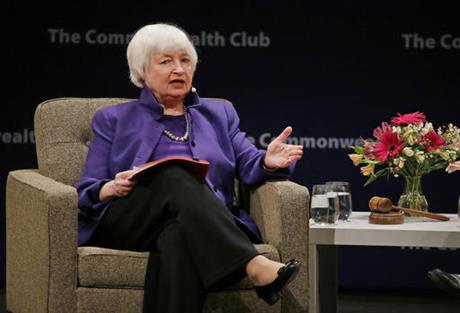 WASHINGTON (AP) — Federal Reserve Chair Janet Yellen says she expects the Fed to raise its benchmark interest rate several times a year through 2019, as it moves closer toward to its economic goals of maximum employment and stable inflation.
WASHINGTON (AP) — Federal Reserve Chair Janet Yellen says she expects the Fed to raise its benchmark interest rate several times a year through 2019, as it moves closer toward to its economic goals of maximum employment and stable inflation.
But in a speech in San Francisco Wednesday, she said she can’t say when the next interest rate will occur or how high rates will rise. She says that will depend on how the economy performs in the coming months.
She says Fed officials, who boosted rates for a second time last month, expect to raise rates “a few times a year” until they have pushed the Fed’s benchmark rate close to 3 percent by the end of 2019. The rate now stands in a range of 0.5 percent to 0.75 percent.
The 3 percent level for the Fed’s target for the federal funds rate, the interest that banks charge each other, is the point that the Fed currently believes is the so-called neutral rate — the level where the Fed’s interest rate policies are not spurring growth or holding it back.
“Right now our foot is still pressing on the gas pedal, though, as I noted, we have eased back a bit,” Yellen said. “Our foot remains on the pedal in part because we want to make sure the economic expansion remains strong enough to withstand an expected shock, given that we don’t have much room to cut interest rates.”
Currently, Yellen said inflation is still running below the Fed’s 2 percent objective, by its preferred measure of prices, and that some measures show that even though unemployment is below 5 percent, there could still be room to make further progress on jobs.
“For instance, wage growth has only recently begun to pick up and remains fairly low,” Yellen said.
She said as the economy gets closer to the Fed’s goals on employment and inflation, it will make sense to “gradually reduce” the level of support the Fed is providing by raising interest rates.
“Waiting too long to begin moving toward the neutral rate could risk a nasty surprise down the road — either too much inflation, financial instability, or both,” Yellen said in her speech to the Commonwealth Club of San Francisco.
During her appearance, Yellen made no mention of the incoming Trump administration. President-election Donald Trump was critical of Yellen during the campaign, accusing the Fed of being political and keeping interest rates low to help Democrats.
Yellen has denied this charge. She has said she intends to remain as Fed chair until her term ends in February 2018.
Yellen was asked how the Fed safeguards its political independence while at the same time strengthening policy coordination with the executive branch.
One long tradition dating back decades, she said, is the Fed chair’s regular meetings with the administration’s Treasury secretary.
“During my time, I have had virtually a weekly breakfast or lunch with Jack Lew,” Yellen said, referring to the current Treasury secretary.
She said the meetings are used for exchanging views on the economy, but she said she has never felt pressure from the administration to follow a particular course on interest rates.
“We share a common interest in the success of the U.S. economy, and the administrations, at least the ones I have experience with, respect the independence of the Fed,” Yellen said.
~Martin Crutsinger, AP



